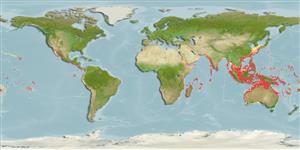Common names from other countries
Classification / Names / Names
Populärnamn | synonymer | Catalog of Fishes (gen., sp.) | ITIS | CoL | WoRMS
Environment: milieu / climate zone / depth range / distribution range
Ekologi
Revassocierade; djupintervall 0 - 100 m (Ref. 99185). Tropical
Indo-West Pacific.
Length at first maturity / Size / Vikt / Age
Maturity: Lm ? range ? - ? cm Max length : 17.0 cm TL hane/ej könsbestämd; (Ref. 92)
One of the most brightly colored stomatopods; with deep blue uropods; those and other appendages lined with bright red setae (Ref 92).
Life cycle and mating behavior
Könsmognad | Reproduktion | Lek | Ägg | Fecundity | Larver
Some members of the order Stomatopoda pair for life and some come together only to mate. Males produce sperm ducts rather than spermatophores; females can brood a maximum of 50,000 eggs. Life cycle: Eggs hatch to a planktonic zoea which lasts for 3 months.
Manning, R.B. 1998. (Ref. 92)
IUCN Red List Status (Ref. 130435: Version 2024-1)
CITES status (Ref. 108899)
Not Evaluated
Not Evaluated
Threat to humans
Harmless
Human uses
Akvarium: Kommersiell
| FishSource |
Verktyg
Ytterligare information
Age/SizeTillväxtLength-weightLength-lengthMorfologiLarverAbundans
Internet-källor
Estimates based on models
Preferred temperature
(Ref.
115969): 24.3 - 29, mean 28 (based on 1610 cells).
Vulnerability
Low vulnerability (10 of 100).
Price category
Unknown.
